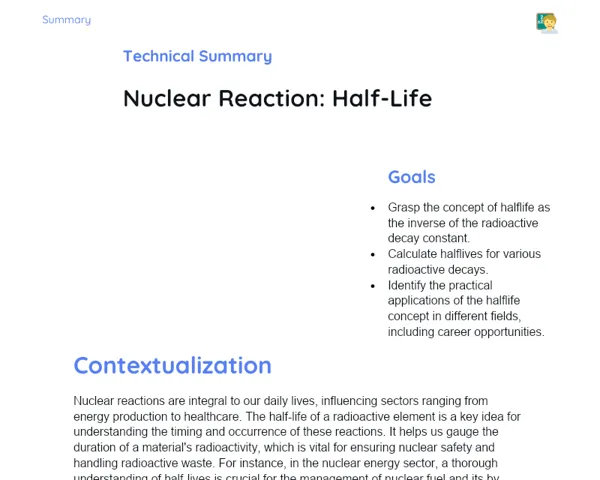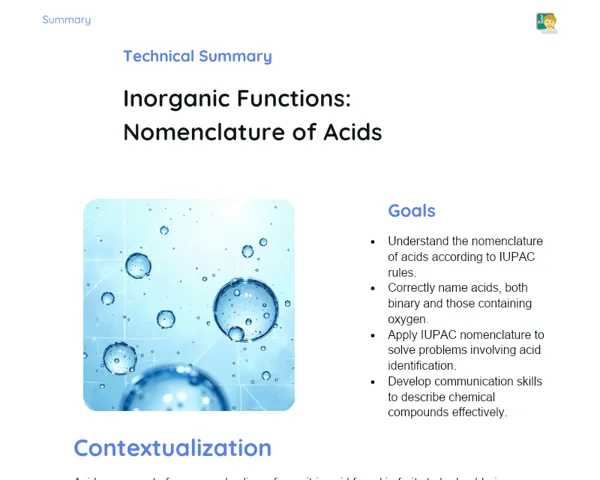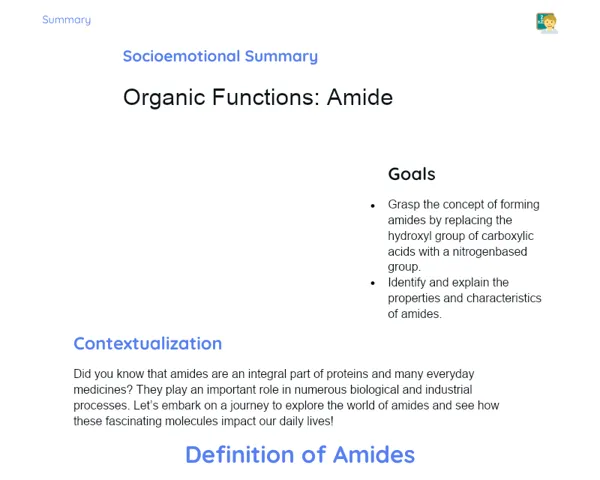Socioemotional Summary Conclusion
Goals
1. 🌟 Grasp the structure of metallic bonding through the idea of an 'electron sea'.
2. 💡 Recognize and explain the properties of metallic compounds, like electrical and thermal conductivity, based on their electronic structure.
Contextualization
🔍 Think about the electrical wires we encounter every day, be it at home, school, or on the streets. Ever wondered why they are made of metal? The magic lies in metallic bonding and the 'electron sea'! These free electrons empower metals to conduct electricity seamlessly. Understanding this bonding not only helps us grasp how our gadgets function but also prompts us to reflect on the significance of flexibility and adaptability in our own lives. 🌐
Exercising Your Knowledge
Structure of Metallic Bonding
Metallic bonding is a vital kind of chemical bond found between metal atoms. It features a lattice of positively charged metal ions surrounded by a 'sea of free electrons'. This arrangement enables the electrons to move freely among the atoms, resulting in a robust bond that gives metals their distinctive properties.
-
🔄 Electron Sea: Electrons flowing freely amongst the metal ions provide internal cohesion and strength to the metal.
-
🌐 Cohesion and Strength: The free movement of electrons allows metals to remain solid yet flexible.
-
🔬 Analogies: Picture a pool filled with balls (metal ions) where the water (electrons) circulates around them, keeping them together without direct contact.
Properties of Metals
Metals showcase exceptional properties owing to their unique electronic structure. Some of these properties include electrical and thermal conductivity, malleability, and ductility. All these characteristics arise from how electrons behave within the metallic framework.
-
⚡ Electrical Conductivity: The free movement of electrons facilitates efficient conduction of electric current, which is crucial for the functioning of electronic devices.
-
🔥 Thermal Conductivity: Free electrons also assist in transferring thermal energy, making metals great conductors of heat, perfect for cooking.
-
🔧 Malleability and Ductility: The 'electron sea' allows metal ions to slide past each other without breaking the structure, enabling metals to be shaped and drawn into wires.
Practical Examples
The ideas of metallic structure and the 'electron sea' aren't just theoretical; they have real-world applications in our daily lives. From electrical cables to frying pans, grasping these properties deepens our appreciation for the role of science in our everyday experiences.
-
🔌 Electrical Cables: Typically made of copper or aluminum, these materials are preferred for their superb electrical conductivity.
-
🍳 Cooking Pans: Items like stainless steel or aluminum are commonly used in cookware for their excellent heat conduction.
-
🏭 Construction and Engineering: Metals are extensively utilized in construction for their strength and malleability.
Key Terms
-
🛠️ Metallic Bonds: A type of chemical bond that occurs between metal atoms, characterized by positively charged metal ions in a 'sea of free electrons'.
-
🌊 Electron Sea: A concept referring to the free circulation of electrons among metal ions, providing cohesion and strength to the metal.
-
⚡ Electrical Conductivity: The ability of metals to conduct electric current efficiently, thanks to the free movement of electrons.
-
🔥 Thermal Conductivity: The ability of metals to efficiently transfer thermal energy, enhanced by their free-moving electrons.
-
🔧 Malleability: A property of metals allowing them to be shaped without breaking, courtesy of the flexibility provided by the 'electron sea'.
-
🧵 Ductility: The ability of metals to be stretched into wires without breaking, also influenced by the 'electron sea'.
For Reflection
-
💭 How can insights into the 'electron sea' alter our perspective on metals in our daily lives?
-
🌱 In what ways can the flexibility and adaptability of electrons in metals be seen as a metaphor for emotional regulation and resilience?
-
🤔 What strategies can you employ to use your knowledge of metallic bonding and its properties in future projects or in addressing practical and emotional challenges you face?
Important Conclusions
-
🔍 Metallic bonding is crucial for understanding the distinctive properties of metals, such as electrical and thermal conductivity, malleability, and ductility.
-
⚡ The 'electron sea' serves as the central concept explaining why metals efficiently conduct electricity and heat.
-
🔧 Familiarizing ourselves with these principles not only helps us appreciate metals in our daily lives but also prepares us for future studies and practical uses.
Impacts on Society
🔥 Impact on Society: Understanding metallic bonding significantly affects our daily lives. Think about the electronic gadgets we use every day, like smartphones, laptops, and televisions – all depend on the efficient electricity conduction enabled by metals. Additionally, the durability and adaptability of metals are essential for construction, enabling strong and versatile structures.
🌱 Emotional Connection: The same features that make metals invaluable in technology and engineering can be viewed as a reflection of our emotional experiences. The flexibility and resilience of electrons within metals remind us of the necessity of being adaptable in the face of daily emotional hurdles. By understanding and applying the concept of 'electron sea', we can learn to manage our emotions effectively, maintaining a balance in our emotional health.
Dealing with Emotions
🧘♀️ RULER Exercise for Home: While studying metallic bonding, take a moment to pause and reflect on your emotions. First, recognize the feelings associated with your study – are you feeling excited, puzzled, or not-so-great? Understand the reasons behind those feelings, whether they stem from difficulty with the content or the joy of learning something new. Label your emotions correctly for better clarity. Express how you feel appropriately, perhaps by discussing with a friend or jotting down in a journal. Lastly, regulate your emotions using techniques like deep breathing or short breaks to stay focused and calm during your studies.
Study Tips
-
📚 Regular Revision: Dedicate time to revisit the concepts covered in class, such as the structure of metallic bonding and the properties of metals. This will solidify your understanding.
-
🧪 Hands-on Experiments: Engage in simple experiments at home, like creating basic circuits, to observe electrical conduction of metals in action. These practical activities enhance theoretical comprehension.
-
📖 Supplementary Resources: Explore educational videos and online articles to complement the discussions from class. Platforms like YouTube and Khan Academy offer excellent resources on metallic bonding.



